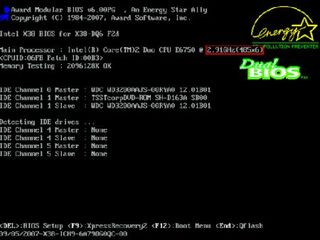Intel X38 Chipset: A Porsche with the Handbrake On
Overclocking - FSB 485 Is The Limit
Since Intel has implemented overclocking support directly into the X38 chipset, we were very interested in determining the maximum FSB speed of the North Bridge. Our overclocking experiment had a disappointing ending, though: the North Bridge of our Gigabyte GA-X38-DQ6 board only reached 480 MHz without a voltage increase.

Even after we tweaked the voltage a little, we were only able to squeeze another 5 MHz out of the board, marking 485 MHz as its upper limit.

For our overclocking test we used A-Data DDR2-1066+ memory, which can easily cope with much higher frequencies. To rule out the CPU as the bottleneck, we used our Core 2 Extreme
QX6850 and Core 2 Duo E6750 samples for our tests, which both use the overclocking-friendly G0 stepping.
You may wonder why we say "only" 485 MHz. Well, we've had much better luck in previous tests. In one of our previous experiments, where we were able to overclock an E6300 from 1.8 GHz to 3.5 GHz using a simple air-cooling solution, we reached an FSB of 500 MHz with our Gigabyte GA 965p-DS3 board based on Intel's old 965 chipset. Stable operation with this board was possible up to an FSB of 490 MHz - a speed at which our X38 sample wouldn't even boot.

It's possible that our X38 board wouldn't boot at speeds above 485 MHz because it isn't optimized for overclocking yet. The board itself, at any rate, carries version number 1.0, which marks it as the retail version you will find in stores.
An FSB of 485 MHz is required in order to overclock a Core 2 Duo E6550 to 3.4 GHz. As the X38 has already reached its limit at this point, it doesn't seem like it will become an overclockers' dream board.
Stay on the Cutting Edge
Join the experts who read Tom's Hardware for the inside track on enthusiast PC tech news — and have for over 25 years. We'll send breaking news and in-depth reviews of CPUs, GPUs, AI, maker hardware and more straight to your inbox.
Current page: Overclocking - FSB 485 Is The Limit
Prev Page PCI-Express 2.0 Next Page New Possibilities For North Bridge CoolingTom's Hardware's dedicated news crew consists of both freelancers and staff with decades of experience reporting on the latest developments in CPUs, GPUs, super computing, Raspberry Pis and more.
Most Popular


